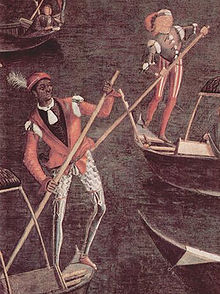Gondolier
A gondolier is the driver of a Venetian gondola .
Driving the gondola
The gondolier stands at the stern beak of the gondola and moves it with a single, starboard rudder , the Remo . This is stored in a wooden fork, the forcula . He also uses house walls and other oncoming boats to maneuver , from which he kicks off with his leg. So the gondolier is not only able to also move the Gondola both forward and backward - to pass around some very low bridges over the canals of Venice, the gondolier also uses the means of weight transfer to the gondola on flip side to put down.
Framework
Up until the 19th century, households in Venice had their own gondolas with gondoliers who were part of the service staff. But there were always gondoliers who owned or co-owned the gondola. With the increasing mass tourism since the middle of the 19th century, which was essentially brought about by the invention of the railway, the gondola service was also commercialized, which brings growing income, but which also ceased when tourism collapsed (First and Second World War, economic crises). There are rumors that the income of a gondola in the season (from April to October) would be around € 500 per day, i.e. € 15,000 per month. This is not really proven.
On July 12, 1868, a society of gondoliers, the Società di Muto Soccorso , was founded, which in 1883 became Cooperativa Vittorio Fasan and was named after Daniele Manin from 1943 . In 1997 it was transformed into a cooperative . The operation of the gondolas in Venice is now regulated by precise specifications and licensing. The licenses are limited in number and very popular. A license can only be obtained when a gondolier retires or surrenders his license. In the past, the licenses were only inherited, it is claimed. The fact is that a state examination as a prerequisite for obtaining a license as a commercial gondola operator was only introduced in 2006. To run a private gondola (e.g. hotel's own), as for all boats in Venice, if they are not used for business purposes, no license is required.
Gondoliera
In 2010, a woman broke into the traditional male domain for the first time: Giorgia Boscolo, daughter of a gondolier, who was officially allowed to join the men's ranks as a gondolier after passing the exam. Her German-American colleague Alexandra Hai, who had previously been wrongly referred to as the first gondolier in some media, never passed the test despite several attempts, which is why she - not on an official mission - was only able to transport the guests of a small hotel chain. In 2017 it became known that she had undergone gender reassignment: Alexandra became Alex, a man.
The only German gondolier is Ina Mierig, who drives her gondola on Hamburg's canals.
See also
Gondolier with a bow in the 19th century, Carlo Naya
Web links
- Gondolier Photo Gallery , accessed October 24, 2008
- A gondolier in Venice , Deutsche Welle TV , August 17, 2016, 5 min., Accessed on August 20, 2016
Individual evidence
- ↑ Alessandro Marzo Magno (La Carrozza Di Venezia. Storia della Gondola. Venezia 2008 p. 46) states, without citing a source, that in 1867 there were around 900 gondolas in Venice. For 1930 Magno p. 74 gives a number of 520, including 484 in the servizio pubblico , ie only 36 private ones ( Gondole de casada ). The last private gondola was that of Peggi Guggenheim (ibid. P. 75). Johann Wilhelm Neumayr von Ramssla wrote in “Reise durch Welschland und Hispanien” (Leipzig 1622) that there were “eight thousand gondolas or little ships” in Venice. See also the website of the Instituzione per la conversazione della gondola e la tutela del gondoliere : www.gondolavenezia.it.
- ↑ Venice - The Gondoliers. In: Süddeutsche Zeitung. August 9, 2001, accessed October 24, 2008 .
- ↑ Venice's first gondolier Alex Hai is now a man In: Spiegel online August 5, 2018.
- ↑ The German Gondoliera Ina Mierig , accessed on June 10, 2020




